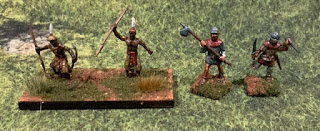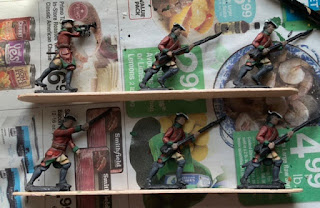There was a brief discussion this past week over on the Reaper Forums about solo games. This reminded me that I had left a battle pending in the Northlands campaign. Since the last Northlands related game I played was a skirmish game back in June, that probably means that it has been pending since some time in July or August.
So, I decided to set it up. I had been avoiding it because it looked like a blow-out; one kingdom’s army had advanced into another’s territory, and, due to bad intelligence (as provided by occasional die rolls to assist in decision making along the way), was attempting to attack without realizing that they were outnumbered about 2:3. But, having been reminded, I thought that I would like to resolve it, so as to clear the way for something more interesting down the line.
I decided to roll at random for one of the 30 scenarios in Neil Thomas’s One Hour Wargames book, and got scenario 7, “Flank Attack”. Not only that, but the dice decreed that the larger force was the ambusher. I thought, “well, that’ll be that”, but then noticed one little peculiarity in the line up. The smaller force (the King of Darmis and his army) had a Magician unit, and the larger force (the King of Verdance and his army) was led by a Hero (i.e. the King, in this case). This being a full scale battle, the rules to be used were Hordes of the Things, and a Hero is particularly vulnerable to a Magician. Hmmm…could be more balanced than it initially appeared, I thought. I rolled a die to see whether the Verdancers were aware of the presence of the Magician, and they were not, so I set the King up to be boldly leading the flanking force.

The Darmish army is on the two hills at the bottom of the picture, facing down the road, and the Verdancers are on the hills by the tower and the edge by the woods, prepared to roll the Darmish up from the left flank. To make this short, the battle lasted two turns (so two moves by each side). The attackers rolled up the hill immediately destroying the unit on the left end, and pushing back the remainder. This brought the King (Hero) within range of the the Magician (Cassara, the Blue Sorceress), and her side got enough activation points each of the two turns to move 1 unit and make one magical attack. The second try succeeded, and, having lost 4 army points (in the form of the Hero/General) to 2 army points (one stand of bows), this amounted to “more and the commander” and the battle was over. Had the Verdance attack killed a second foot soldier unit on their second turn, it would have been 4 and 4 (i.e. not “more”) and the loss of the general would have been serious but not immediately fatal.
This made a good solo game; if someone else had come over to play this, I would have felt bad about giving them either side, knowing from experience that it was going to be a pretty random thing as to whether the magic attack would succeed.
Since the actual game only took a few minutes, I decided that I would write it up in proper style. Now it’s back to the map and notebook play, to finish out the campaign year’s record keeping, and figure out the next map moves. With the capture of the King of Verdance, I suddenly have a need to know more about his family and possible factions within the kingdom.
I also note that the campaign year included only two pitched battles, with the other one being the
Battle of the Crossroads, which was fought all the way back in May 2019. Both of these battles were ended when Cassara the Blue Sorceress took out the opposing general. Perhaps the Blue Order will be looking for some increase in its standing within the Kingdom of Darmis as well? I have considered the question of whether I might use this campaign map for a roleplaying game as well as a wargames campaign, and it is starting to look like adventure hooks just write themselves …
I am hoping that the second campaign year will move along a little more quickly than the first.











